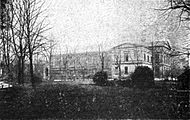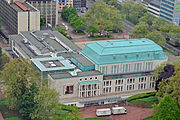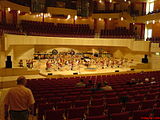Saalbau Essen
The hall building is a concert hall in Essen's southern district and is now the seat of the Essen Philharmonic with associated catering and event areas. The building is centrally located in the city center on the edge of the city garden and near the Aalto Theater . Tomáš Netopil has been General Music Director of the Essen Philharmonic Orchestra since the 2013/2014 season and thus successor to Stefan Soltesz . Hein Mulders succeeded Johannes Bultmann as artistic director at the beginning of the 2013/14 season.
history
City garden hall 1864
A first concert and event hall at the same location, the then so-called Stadtgartensaal, was completed in 1864. The initiative to build such a structure, the acquisition of land and the financing, was based on private, civic engagement. A large ballroom was housed in a half-timbered building, which was supplemented by a simple restoration building in solid construction.
The hall construction as a concert hall in 1904
In 1901 the city garden hall was demolished and a spacious and representative concert hall was built on the same site - the first hall building. The city councilor and entrepreneur from Essen, Richard Bömke , made a particular contribution to this, whereupon he was appointed to the council of commerce . The building was created after a two-stage architectural competition, from which the joint design by the architects Skjøld Neckelmann (Stuttgart) and Carl Nordmann (Essen) was determined for implementation. The foundation stone was laid on June 9, 1902. Richard Strauss conducted the inauguration on September 24, 1904 . The architecture of the building was influenced by Art Nouveau .
The building of the hall has repeatedly been the scene of remarkable musical performances, for example Gustav Mahler conducted the world premiere of his 6th symphony here in 1906 as part of the 42nd Tonkünstlerfest of the Tonkünstlerversammlung of the Allgemeine Deutsche Musikverein , followed in 1913 by Max Reger with the world premiere of his Böcklin Suite . There was an organ from Furtwängler & Hammer in the large hall .
Destruction and rebuilding
The old hall building existed until July 26, 1943, when almost the entire inner city of Essen, including the hall building, suffered severe damage during an Allied bombing raid in World War II .
From 1949, a modernized reconstruction was carried out in the simple style of the 1950s, taking into account the building fabric that was still usable. The inauguration of the main building with a large concert hall took place on November 14, 1950. After that, the entrance wing was rebuilt in a second construction phase. Walter Engelhardt designed the entire reconstruction. He also directed its artistic design. Since then, the hall has also served as a large conference or smaller sports facility as well as various musical performances and celebrations. An important external feature was and is the copper-clad mansard roof, which has been reused. One of the smaller halls, the so-called White Hall, contained a unique ceramic wall by Charles Crodel . The great hall was described as having 1773 seats and a 200 square meter podium. In 1951 he received a Klais organ with 6,305 organ pipes , 80 stops , five manuals and a pedal .
Philharmonic today
Between 2002 and 2004 the hall building as the seat of the Philharmonie Essen was renovated for 75 million euros and provided with new technical equipment. Most of the costs were borne by donations from businesses and foundations; the state of North Rhine-Westphalia also took on around eight million euros. The central axes of the building were opened. Today it is possible to look from one end of the building to the other. The Alfried-Krupp-Saal was extended to the rear by the area of today's ranks. Finally, on June 4, 2004, the new concert and event location reopened.
Entrance area and foyer
Part of the building was restored to its 1950s condition, such as the entrance area and the foyer.
In the area of the main entrance there are some small ticket booths, historical chandeliers hang on the ceiling and on the walls there are still shadows of the originally installed lamps and opposite the shadows of a lettering originally located there. After the renovation in 2004, these cash registers were back in operation for a short time - but not in the long term. a. because the cash desks are unsuitable or too small for the requirements of today's cash registers (no cabling, no space for screens, printers, fax, not enough space for customers in the checkout area who not only sell tickets for the Philharmonie, but also for numerous other events other venues).
The cloakroom side of the foyer is made of marble, the other side is just cheap concrete. This corresponds to the way in which this part of the building was built in the 1950s when there was a lack of money. After opening the visual axes, a view from the conference area, over the foyer, through the concert area to the opposite window front of the building towards the Aalto-Theater is possible today .
Alfried Krupp Hall
The Alfried Krupp Hall is the central and largest event hall. It has light wood paneling and warm tones. The red steel elements should indicate the Krupp company. Acoustical tests by Müller-BBM on a replica of parts of the hall on a 1: 1 scale showed that these steel elements should not be clad for reasons of sound breakage. They are therefore visible today without disguise. On 680 square meters, the hall offers 360 seats at round tables or 1906 seats in the characteristic red and warm row seating, 40 of which are standing in the second tier. The circular segments of the stage area are height-adjustable so that the stage can be adapted to the size of the ensemble playing. The stage area and the entire parquet area can be raised to the level of the balcony. In this way, the hall can be used as a ballroom or for shareholders or party meetings. The sound sail hanging from the ceiling has a diameter of eleven meters and a weight of 18 tons. It is height-adjustable: it can be lowered for chamber concerts and smaller events. The hall has a total height of 21 meters, the second tier is 14 meters high. A Kuhn organ is now installed at the head of the hall .
The Alfried-Krupp-Saal, located in the Philharmonie, is structurally separated from the rest of the building: At the individual hall entrances there are 2.6 meter long transitions into the hall. There is a corresponding distance between the inside and outside of the hall, in which on the one hand the paths for the emergency exits run. On the other hand, this separation also serves to acoustically separate the hall from the rest of the building.
Outside the hall, immediately behind the stage area, there is a semicircular room that can be used. a. is particularly suitable for recording CDs. Although this room is located directly behind the Kuhn organ and although the semicircular outside faces towards Huyssenallee, the room is sonically isolated: apart from organ tones from the bass area, no sounds from the Alfried Krupp Hall or from the street area penetrate the room .
RWE pavilion
The RWE pavilion, sponsored by the energy supplier, was rebuilt between the two stairwells of the hall building in addition to the historic building as part of the renovation between 2002 and 2004. The light-flooded glass cube is used for events where a small number of spectators are expected. On 412 square meters, it offers 252 seats at round tables or 400 seats in row seating. The pavilion is made of glass and metal elements in lightweight construction. There is another, second glass roof above the glass roof, which protects against annoying rain or hail noises. The distinctive curtains on the four inner sides of the pavilion ensure a consistently good sound regardless of the number of spectators and the seating. They also help to ensure that the pavilion is soundproof and securely separated from the rest of the building. In this way, different events can take place in the pavilion and, for example, in the Alfried Krupp Hall at the same time, without the two events influencing each other. There were works of art by Thomas Schütte on the front and back inside of the pavilion : the rings, illuminated in changing light, are intended to slow the visitor down and create a calm atmosphere. The sculptures were removed in 2015 due to the risk of vandalism.
Ballroom
The festival hall offers between 54 seats in U-shape and up to 238 seats in rows on 205 square meters. The wall paneling is made of mahogany and pearwood that could be preserved. The noble parquet floor and the stucco ceiling are reproductions. The hall has a stage with a small artist's dressing room. It is particularly suitable for lecture events, banquets or celebrations with dance. The air conditioning from the 1950s has been preserved in the side walls of the hall.
Colorful halls
The colorful halls of the Philharmonie Conference Center are located above next to the foyer. One white, one yellow and one green hall offers space between 75 square meters with 24 seats and 139 square meters with 137 seats.
The white hall is the middle of the three halls. It contains a ceramic wall by Charles Crodel from the 1950s. This was covered and was rediscovered during the renovation work. It contains motifs from European fairy tales and classical mythology and thus creates an artistic and unobtrusive ambience.
The yellow hall has walls with lemon wood veneer and enamelled and lightly gilded green terracotta ribbons, a yellow-covered bench and several silk prints by the Düsseldorf artist Oswald Petersen from 1954. The religious prints show, among other things, the building of the Fürstin-Franziska-Christine-Stiftung and the golden Madonna .
The green room has a pear tree veneer that was wallpapered over during previous renovations. In 2004 it was exposed again so that the hall has regained its Bauhaus ambience. Like the other two halls, the window front of the green room faces the city garden.
The three halls can be connected to one long hall by opening the double doors between them.
Club rooms
The three club rooms Richard Strauss , Gustav Mahler and Max Reger offer space on 17 square meters with ten seats and up to 42 square meters with 44 seats.
Kuhn organ
The organ in the concert hall of the Philharmonie was built in 2004 by the organ manufacturer Kuhn . It replaces the old Klais organ from 1951, which was dismantled. Parts of it went to the Matki Boskiej Kochawińskiej church in Gliwice , the gaming table went to the St. Peter and Paul Church in Straelen . Today Kuhn organ in the hall building has 62 registers (4502 whistling , grinding shop ) on three manuals and pedal . The cost was around 1.2 million euros. The instrument weighs around 24 tons and fills a good 300 cubic meters of space. The largest pipe measures around 4.80 meters. Most of the pipes (like those in the brochure ) are made of a tin-lead alloy, 178 are made of wood. On the front of the organ, the 61 pipes of the tuba en chamade protrude horizontally into the room. In the middle of the organ, on a small gallery, is the console. The action action is mechanical, the stop actions are electric. In addition, there is a mobile electric console that can be used anywhere on the stage, allowing the organist to interact more directly with the choir and orchestra.
|
|
|
|
||||||||||||||||||||||||||||||||||||||||||||||||||||||||||||||||||||||||||||||||||||||||||||||||||||||||||||||||||||||||||||||||||||||||||||||||||||||||||||||||||||||||||||||||||||||||||||||
- Coupling : II / I, III / I, III / II, III 16 '/ I, I / P, II / P, III / P, III 4' / P
- Playing aids : 11x500 electronic typesetting system , floppy disk drive.
Conductor of the Essen Philharmonic
- 1899–1911: Georg Hendrik Witte
- 1911–1916: Hermann Abendroth
- 1916–1933: Max Fiedler
- 1933–1936: Johannes Schüler
- 1936–1943: Albert Bittner
- 1943–1975: Gustav König
- 1975–1991: Heinz Wallberg
- 1991–1997: Wolf-Dieter Hauschild
- 1997–2013: Stefan Soltesz
- since 2013: Tomáš Netopil
literature
- Matthias Kitschenberg: Saalbau is on the list of monuments. In: Preservation of monuments in the Rhineland. No. 4, 1999, ISSN 0177-2619 , pp. 166-169.
Web links
- Philharmonie Essen with pictures of the individual halls
- Saalbau monument (PDF file; 927 kB)
Individual evidence
- ↑ Dirk Aschendorf: Hein Mulders becomes artistic director for the Aalto Theater and Philharmonic in Essen. In: Der Westen.de May 9, 2011, accessed January 24, 2019
- ↑ a b Die Feststätte des Ruhrgebiets , In: Essener Woche , No. 5., 16. – 23. June 1951
- ^ C. Steckner, Charles Crodel's monumentale Bildkeramik, Keramos, issue 164, April 1999, p. 59 ff.
- ^ Land administration city of Essen GmbH (GVE): Philharmonie Essen ; accessed on January 24, 2019
- ↑ Philharmonie Essen, Alfried-Krupp-Saal ; offline
- ↑ Philharmonie Essen, RWE pavilion ; offline
- ↑ Philharmonie Essen, ballroom ; offline
- ↑ Philharmonie Essen, Yellow Hall ; offline
- ↑ Philharmonie Essen, White Hall ; offline
- ↑ More information about the Philharmonie Essen: Kuhn organ ; offline
Coordinates: 51 ° 26 '47 " N , 7 ° 0' 38" E






